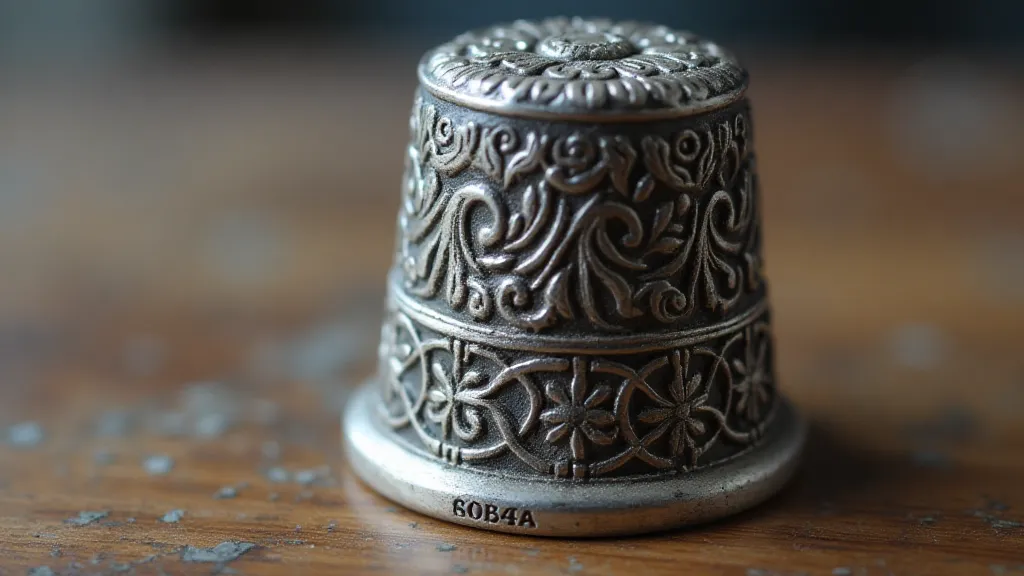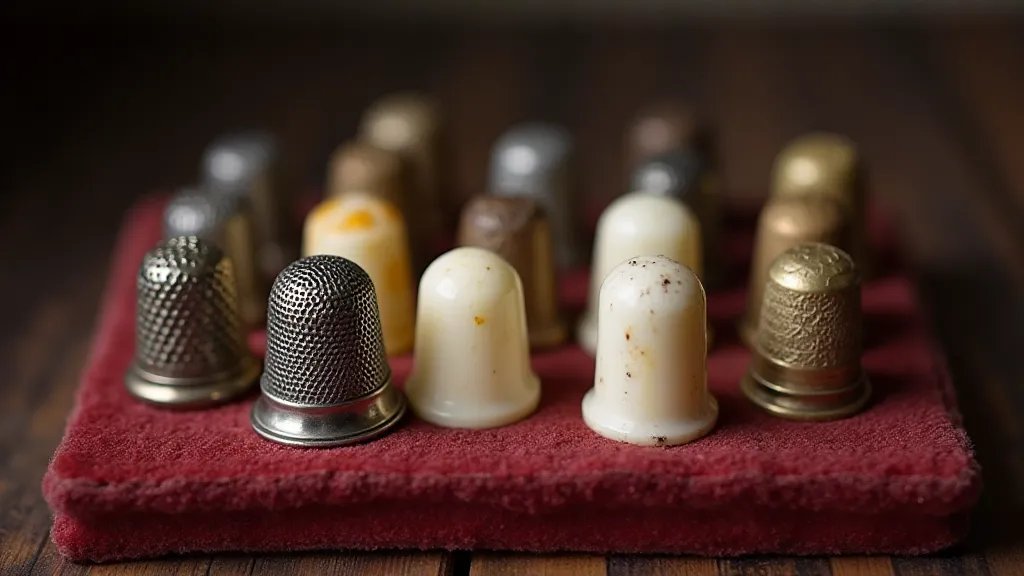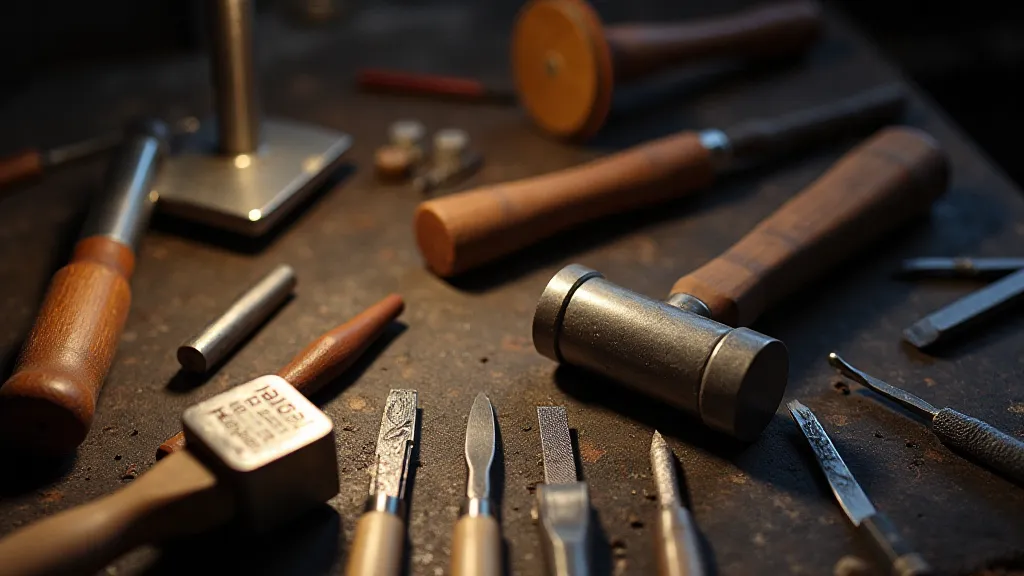The Clockmaker’s Legacy: Precision Engineering in Miniature Thimble Craftsmanship
There’s a quiet elegance to antique thimbles that transcends their simple purpose. They’re not mere tools; they’re miniature testaments to human ingenuity, echoes of a time when craft was paramount and even the smallest object demanded meticulous care. To truly appreciate these tiny treasures, one must understand the surprising connection they share with the revered art of clockmaking – a legacy of precision engineering etched into metal and bone.
My grandmother, Elsie, passed down a small collection of thimbles to me. I recall sitting at her feet, fascinated by the array of shapes, materials, and designs. She’s the one who first pointed out the remarkable quality of some of them, remarking, "These weren't just made, dear, they were
The Intersection of Time and Stitch
The historical context is vital. During the 18th and 19th centuries, when the heyday of antique thimbles arrived, the skills of the clockmaker were highly prized. Master clockmakers possessed a profound understanding of gears, levers, and the intricate interplay of moving parts. This mastery, born from demanding tolerances and unrelenting precision, was a sought-after attribute in other trades. Thimble making, especially the creation of those crafted from precious metals like silver and gold, benefited immensely from this influx of expertise.
Consider the fundamental requirements. A thimble needs to be perfectly round, smooth, and durable. A tiny imperfection can make it uncomfortable, even unusable. A chipped edge, a slight warping – these betray a lack of attention to detail, a compromise in the process. The same principles applied to crafting the delicate gears of a pocket watch. Both demanded consistent, exacting standards. Early thimbles, particularly those produced by skilled silversmiths, often exhibit a level of refinement mirroring the best clockwork mechanisms.

Materials and Techniques: A Master’s Touch
The materials used in antique thimble production further underscore the connection to fine craftsmanship. Silver, particularly sterling silver, was a favored choice, not just for its beauty but for its malleability and ability to hold intricate designs. Brass and pewter were also common, allowing for a wider range of affordable options. Bone and horn thimbles, often hand-carved, speak to a different kind of artistry – one reliant on patience and an intimate knowledge of the material's properties. The evolving portability of these collections, often held close and treasured, is a story in itself; one can almost imagine a glimpse into their journey through time – a connection to the silent echoes of their past.
The techniques employed were equally demanding. Silversmiths utilized a combination of hammering, filing, and engraving to achieve the desired shape and detail. The process of raising a silver thimble – drawing the metal from a flat sheet into a three-dimensional form – required a steady hand and years of practice. Engraving, often done by hand, allowed for the addition of decorative motifs – flowers, animals, and even scenes of everyday life – transforming a functional object into a miniature work of art.
Interestingly, the tools used were often shared between clockmakers and silversmiths. Small, specialized files, gravers for engraving, and burnishers – all essential for achieving the desired precision – were highly valued and carefully maintained. To handle such tools demanded a keen eye and a steady hand; qualities universally appreciated across both crafts.
Identifying Key Characteristics: A Collector’s Eye
So, how can you identify an antique thimble with the hallmarks of that clockmaker’s legacy? Several key characteristics are worth noting. First, examine the material. Look for sterling silver hallmarks – small stamps indicating the purity of the silver. These are usually located on the rim of the thimble. The presence of a hallmark is a strong indicator of quality and age.
Next, scrutinize the construction. Finely raised silver thimbles, those that appear seamlessly formed, are more likely to be of higher quality. Look for sharp, clean lines and a uniform thickness. The presence of hand-engraved details is another positive sign – these are far more labor-intensive than mass-produced markings.
Consider the wear patterns. While all antique thimbles will exhibit some signs of use, the nature of the wear can reveal a great deal. Even wear across the entire surface suggests regular use, while concentrated wear in specific areas may indicate a particular sewing style or even a quirk of the original owner's technique. Perhaps, the original owner meticulously charted courses, a connection with the art of mapping their own world.

Beyond Function: The Emotional Resonance
But the true value of antique thimbles lies beyond their material worth or historical significance. They represent a connection to the past, a tangible link to generations of seamstresses and tailors who relied on these tiny tools to create beautiful and functional garments. Holding a well-worn thimble, feeling the smooth curve against your fingertip, evokes a sense of continuity – a feeling of being part of a larger narrative.
My grandmother’s thimbles weren’t just objects to be admired; they were conversation starters, a doorway to stories of her own mother and grandmother, both skilled seamstresses who plied their trade with needles, thread, and these very same tools. They were, in a way, portals to a simpler time, a time when craftsmanship was revered and even the smallest details mattered. That’s the legacy that resonates most powerfully.
Restoration and Preservation: A Gentle Approach
If you’re considering restoring an antique thimble, proceed with caution. These are delicate objects, and aggressive cleaning or polishing can easily damage their patina and historical value. Gentle cleaning with a soft cloth is usually sufficient. Avoid harsh chemicals or abrasive materials. The goal is to preserve the thimble's character and charm, not to make it look brand new.
Proper storage is also crucial. Keep thimbles in a safe place, protected from dust, moisture, and direct sunlight. Individual pouches or small boxes are ideal for preventing scratches and tarnish.

The act of creating something beautiful, the quiet hum of the needle against fabric, the patient skill required to master a craft - these are all echoes of a rich history. It's worth considering the ways that tactile objects foster a link to our inner world, a connection with the quiet symphony of shared experiences.
Perhaps, as textile traditions fade, there’s a renewed need to honor these miniature artifacts, to understand their connection to larger narratives of human ingenuity. It’s not just about preserving objects; it’s about preserving the stories they carry, the lives they touched, and the skills they embody. These tiny vessels of history invite us to slow down, to appreciate the beauty in the small things, and to connect with the enduring legacy of human craftsmanship.
The stories woven into antique textiles, the gentle clicking of thimbles – these are fragments of a fading world, precious reminders of a time when craftsmanship reigned supreme. And perhaps, by honoring these miniature artifacts, we can help to ensure that their stories continue to be told for generations to come. The ephemeral echoes of such practices are vital to understanding our place in history.
The connection between hand-sewing, textile creation, and the quiet joy of collecting isn't merely about accumulating objects; it's about preserving a way of life, a link to our ancestors, and a reminder of the enduring power of human creativity.
Consider the way that objects, particularly those imbued with history and artistry, can trigger a sense of connection to our ancestors, to a world that’s both familiar and distant. These miniature artifacts are more than just tools; they are vessels of memory, tiny portals to a simpler time.
The appreciation for these small treasures continues to grow, as individuals seek to reconnect with the tangible world, to rediscover the joy of creating something with their own hands, and to honor the skills of those who came before us. It’s a testament to the enduring power of craftsmanship, and a reminder that even the smallest objects can hold the echoes of a rich and fascinating history.
These small vessels of history are a window into a world that is both distant and familiar, a time when craftsmanship was revered, and even the smallest details mattered. They are a reminder that even the smallest objects can hold the echoes of a rich and fascinating history.





